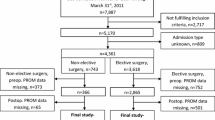Abstract
Factors as age, sex, smoking, duration of leg pain, working status, type/level of disc herniation and psychosocial factors have been demonstrated to be of importance for short-term results after lumbar discectomy. There are few studies with long-term follow-up. In this prospective study of lumbar disc herniation patients undergoing surgery, the result was evaluated at 2 and 5–10 (mean 7.3) years after surgery. Predictive factors for satisfaction with treatment and objective outcome were investigated. Out of the included 171 patients undergoing lumbar discectomy, 154 (90%) patients completed the 2-year follow-up and 140 (81%) completed the long-term follow-up. Baseline data and questionnaires about leg- and back pain intensity (VAS), duration of leg pain, disability (Oswestry Disability Index), depression (Zung Depression Scale), sick leave and employment status were obtained preoperatively, at 2-year- and long-term follow-up. Primary outcome included patient satisfaction with treatment (at both time points) and assessment of an independent observer at the 2-year follow-up. Secondary outcomes at 2-year follow-up were improvement of leg and back pain, working capacity and the need for analgesics or sleeping pills. In about 70% of the patients excellent or good overall result was reported at both follow-ups, with subjective outcome measurements. The objective evaluation after 2 years was in agreement with this result. Time on sick leave was found to be a clinically important predictor of the primary outcomes, with a potential of changing the probability of a satisfactory outcome (both objective and subjective) from around 50% (sick leave >3 months) to 80% (sick leave <2 months). Time on sick leave was also an important predictor for several of the secondary outcomes; e.g. working capacity and the need for analgesics.

Similar content being viewed by others
References
Ng LC, Sell P (2004) Predictive value of the duration of sciatica for lumbar discectomy. A prospective cohort study. J Bone Joint Surg Br 86(4):546–549
Atlas SJ et al (2005) Long-term outcomes of surgical and nonsurgical management of sciatica secondary to a lumbar disc herniation: 10 year results from the Maine lumbar spine study. Spine 30(8):927–935
Asch HL et al (2002) Prospective multiple outcomes study of outpatient lumbar microdiscectomy: should 75 to 80% success rates be the norm? J Neurosurg 96(1 Suppl):34–44
Dewing CB et al (2008) The outcomes of lumbar microdiscectomy in a young, active population: correlation by herniation type and level. Spine 33(1):33–38
Ronnberg K et al (2007) Patients’ satisfaction with provided care/information and expectations on clinical outcome after lumbar disc herniation surgery. Spine (Phila Pa 1976) 32(2):256–261
Hakkinen A et al (2003) Does the outcome 2 months after lumbar disc surgery predict the outcome 12 months later? Disabil Rehabil 25(17):968–972
Loupasis GA et al (1999) Seven- to 20-year outcome of lumbar discectomy. Spine (Phila Pa 1976) 24(22):2313–2317
Weber H (1983) Lumbar disc herniation. A controlled, prospective study with ten years of observation. Spine (Phila Pa 1976) 8(2):131–140
Weinstein JN et al (2008) Surgical versus nonoperative treatment for lumbar disc herniation: four-year results for the Spine Patient Outcomes Research Trial (SPORT). Spine 33(25):2789–2800
Rothoerl RD et al (1998) Are there differences in the symptoms, signs and outcome after lumbar disc surgery in the elderly compared with younger patients? Br J Neurosurg 12(3):250–253
Peul WC et al (2008) Influence of gender and other prognostic factors on outcome of sciatica. Pain 138(1):180–191
Nygaard OP, Kloster R, Solberg T (2000) Duration of leg pain as a predictor of outcome after surgery for lumbar disc herniation: a prospective cohort study with 1-year follow up. J Neurosurg 92(2 Suppl):131–134
Rothoerl RD, Woertgen C, Brawanski A (2002) When should conservative treatment for lumbar disc herniation be ceased and surgery considered? Neurosurg Rev 25(3):162–165
Almeida DB et al (2007) Is preoperative occupation related to long-term pain in patients operated for lumbar disc herniation? Arq Neuropsiquiatr 65(3B):758–763
Halldin K et al (2009) Three-dimensional radiological classification of lumbar disc herniation in relation to surgical outcome. Int Orthop 33(3):725–730
Carragee EJ et al (2003) Clinical outcomes after lumbar discectomy for sciatica: the effects of fragment type and anular competence. J Bone Joint Surg Am 85-A(1):102–108
Kohlboeck G et al (2004) Prognosis of multifactorial outcome in lumbar discectomy: a prospective longitudinal study investigating patients with disc prolapse. Clin J Pain 20(6):455–461
Junge A et al (1996) Predictors of bad and good outcome of lumbar spine surgery. A prospective clinical study with 2 years’ follow up. Spine 21(9):1056–1064 (discussion 1064–1065)
Zung WW (1965) A self-rating depression scale. Arch Gen Psychiatry 12:63–70
Fairbank JC, Pynsent PB (2000) The Oswestry Disability Index. Spine 25(22):2940–2952 (discussion 2952)
Fairbank JC et al (1980) The Oswestry low back pain disability questionnaire. Physiotherapy 66(8):271–273
Macnab I (1973) Chapter 14. Pain and disability in degenerative disc disease. Clin Neurosurg 20:193–196
Nygaard OP, Romner B, Trumpy JH (1994) Duration of symptoms as a predictor of outcome after lumbar disc surgery. Acta Neurochir (Wien) 128(1–4):53–56
Kitze K et al (2008) Preoperative predictors for the return to work of herniated disc patients. Zentralbl Neurochir 69(1):7–13
Hurme M, Alaranta H (1987) Factors predicting the result of surgery for lumbar intervertebral disc herniation. Spine 12(9):933–938
Ronnberg K et al (2008) Peridural scar and its relation to clinical outcome: a randomised study on surgically treated lumbar disc herniation patients. Eur Spine J 17(12):1714–1720
Acknowledgments
The study was supported with grants from Marianne och Marcus Wallenberg’s Foundation, ALF Västra Götaland, Gothenburg Medical association, The Swedish Society of Medicine and the The Neubergh Foundation.
Author information
Authors and Affiliations
Corresponding author
Additional information
An erratum to this article can be found at http://dx.doi.org/10.1007/s00586-010-1511-x
Rights and permissions
About this article
Cite this article
Silverplats, K., Lind, B., Zoëga, B. et al. Clinical factors of importance for outcome after lumbar disc herniation surgery: long-term follow-up. Eur Spine J 19, 1459–1467 (2010). https://doi.org/10.1007/s00586-010-1433-7
Received:
Revised:
Accepted:
Published:
Issue Date:
DOI: https://doi.org/10.1007/s00586-010-1433-7




